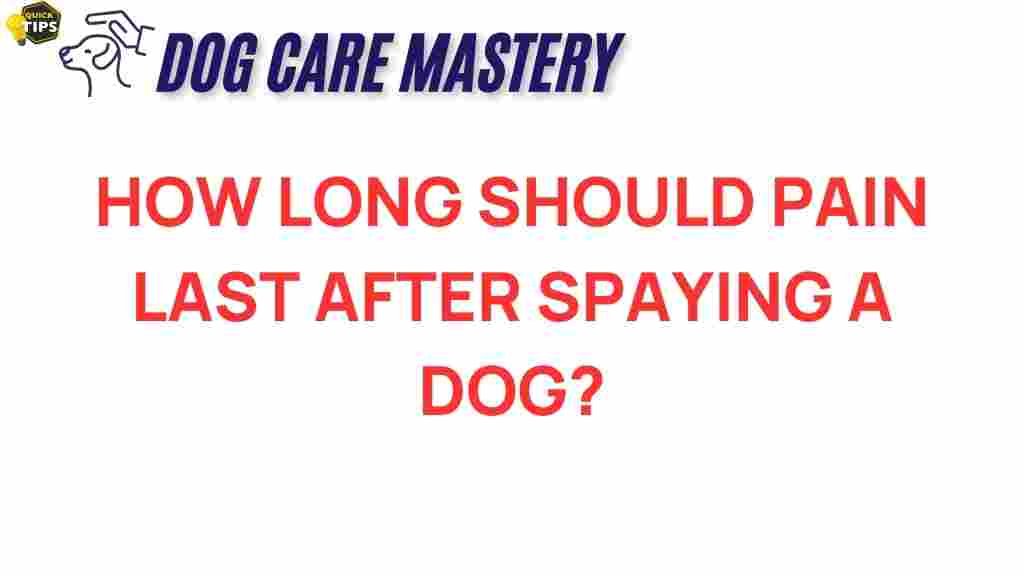Understanding Post-Surgery Pain: How Long Should It Last After Dog Spaying?
Spaying is a common surgical procedure for female dogs that involves the removal of the ovaries and usually the uterus. While it’s a routine operation, many pet owners worry about the pain and recovery time associated with dog spaying. In this article, we will explore what to expect in terms of post-surgery pain, how long it typically lasts, and what you can do to help your furry friend recover comfortably.
What Happens During Dog Spaying?
Before addressing post-surgery pain, it’s essential to understand what the procedure entails. Spaying involves the following steps:
- Preparation: Your dog will undergo pre-surgical examinations, including blood tests, to ensure she is healthy enough for the procedure.
- Anesthesia: Your dog will be placed under general anesthesia to prevent pain and discomfort during the surgery.
- Surgery: The veterinarian will make an incision in the abdomen, remove the ovaries (and usually the uterus), and then close the incision with sutures.
The entire process typically lasts between 30 minutes to an hour, after which your dog will be monitored as she wakes up from anesthesia.
Understanding Post-Surgery Pain
After dog spaying, it’s normal for your pet to experience some level of discomfort. This discomfort can manifest as:
- Whining or whimpering
- Reluctance to move or play
- Excessive licking of the surgery site
- Changes in appetite
Understanding the factors that contribute to post-surgery pain can help you anticipate and manage your dog’s recovery more effectively.
How Long Should Pain Last After Dog Spaying?
The duration of post-surgery pain can vary based on several factors:
- Individual Pain Tolerance: Just like humans, dogs have different pain thresholds.
- Age and Health: Younger and healthier dogs tend to recover faster than older or ailing dogs.
- Surgical Technique: Minimally invasive techniques can result in less pain and quicker recovery times.
Generally, you can expect your dog to experience discomfort for about 3 to 5 days post-surgery. However, some dogs may show signs of discomfort for up to a week. If your dog’s pain seems excessive or continues beyond this timeframe, it’s crucial to consult your veterinarian.
Signs of Normal vs. Abnormal Pain
Recognizing the difference between normal and abnormal post-surgery pain is vital for your dog’s recovery. Here’s what to look for:
- Normal Pain: Mild to moderate discomfort, slight lethargy, and reduced appetite.
- Abnormal Pain: Severe pain (whining, aggression), excessive licking or biting at the incision site, swelling or discharge from the incision, or refusal to eat or drink for more than 24 hours.
If you notice any of the abnormal signs, reach out to your veterinarian immediately for advice.
Managing Post-Surgery Pain
Fortunately, there are several ways to manage your dog’s pain after spaying:
- Medications: Your veterinarian will likely prescribe pain relief medications. Follow their instructions carefully regarding dosages and timings.
- Rest: Ensure your dog has a quiet and comfortable place to recover. Limit her activity to prevent strain on the incision.
- Monitor the Incision: Check the incision daily for signs of infection or unusual swelling.
- Diet: Feed her small, easily digestible meals to help with recovery.
Step-by-Step Recovery Guide
To ensure a smooth recovery after dog spaying, follow this step-by-step guide:
- Day 1-2: Allow your dog to rest. Monitor her closely and administer any prescribed medications.
- Day 3-5: Continue to limit activity. Gradually introduce light walks as tolerated.
- Day 6-7: If your dog is healing well, you may start to return to her regular routine, but avoid vigorous activities until cleared by the vet.
- Post-Operative Check: Schedule a follow-up visit with your vet to ensure proper healing and to remove stitches if applicable.
Troubleshooting Common Issues
While most dogs recover smoothly, you may encounter some common issues:
- Licking at the Incision: Use an Elizabethan collar (cone) to prevent your dog from licking the surgical site.
- Appetite Changes: If your dog refuses to eat, try offering small amounts of bland food like boiled chicken and rice.
- Excessive Lethargy: If your dog seems unusually tired or disinterested in her surroundings, consult your vet.
For more tips on post-surgery care, consider visiting this resource.
When to Contact Your Veterinarian
Knowing when to reach out for professional help is crucial to your dog’s recovery. You should contact your veterinarian if:
- Your dog shows signs of severe pain that is not alleviated by medication.
- The incision appears red, swollen, or has discharge.
- Your dog refuses to eat for more than 24 hours.
- She exhibits signs of vomiting or diarrhea.
Early intervention can prevent complications and ensure your dog’s recovery is as smooth as possible.
Conclusion
Understanding post-surgery pain after dog spaying is essential for every pet owner. While it’s normal for your dog to experience discomfort for a few days following the procedure, knowing how to manage that pain and when to seek help can make a significant difference in her recovery process. Always monitor her closely, follow your veterinarian’s recommendations, and provide a comfortable healing environment. With your support, your furry friend will be back to her playful self in no time!
For more information about dog spaying and pet care, check out this helpful article.
This article is in the category Health and created by dogcaremastery Team
